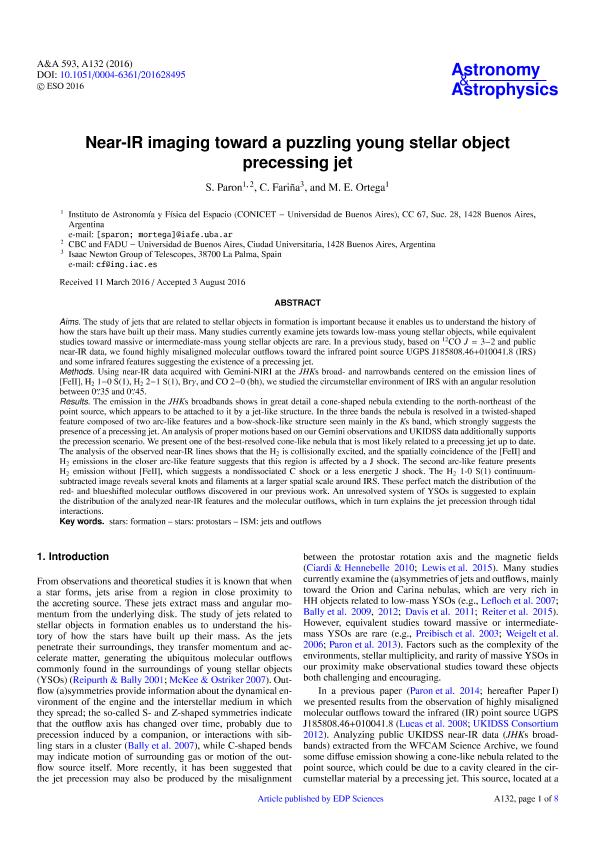Mostrar el registro sencillo del ítem
dc.contributor.author
Paron, Sergio Ariel

dc.contributor.author
Fariña, C.
dc.contributor.author
Ortega, Martin Eduardo

dc.date.available
2017-07-28T19:47:31Z
dc.date.issued
2016-08
dc.identifier.citation
Paron, Sergio Ariel; Fariña, C.; Ortega, Martin Eduardo; Near-IR imaging towards a puzzling young stellar object precessing jet; EDP Sciences; Astronomy and Astrophysics; 593; A132; 8-2016; 1-8
dc.identifier.issn
0004-6361
dc.identifier.uri
http://hdl.handle.net/11336/21555
dc.description.abstract
Aims. The study of jets that are related to stellar objects in formation is important because it enables us to understand the history of how the stars have built up their mass. Many studies currently examine jets towards low-mass young stellar objects, while equivalent studies toward massive or intermediate-mass young stellar objects are rare. In a previous study, based on 12CO J = 3−2 and public near-IR data, we found highly misaligned molecular outflows toward the infrared point source UGPS J185808.46+010041.8 (IRS) and some infrared features suggesting the existence of a precessing jet. Methods. Using near-IR data acquired with Gemini-NIRI at the JHKs broad- and narrowbands centered on the emission lines of [FeII], H2 1−0 S(1), H2 2−1 S(1), Brγ, and CO 2−0 (bh), we studied the circumstellar environment of IRS with an angular resolution between 000 .35 and 000 .45. Results. The emission in the JHKs broadbands shows in great detail a cone-shaped nebula extending to the north-northeast of the point source, which appears to be attached to it by a jet-like structure. In the three bands the nebula is resolved in a twisted-shaped feature composed of two arc-like features and a bow-shock-like structure seen mainly in the Ks band, which strongly suggests the presence of a precessing jet. An analysis of proper motions based on our Gemini observations and UKIDSS data additionally supports the precession scenario. We present one of the best-resolved cone-like nebula that is most likely related to a precessing jet up to date. The analysis of the observed near-IR lines shows that the H2 is collisionally excited, and the spatially coincidence of the [FeII] and H2 emissions in the closer arc-like feature suggests that this region is affected by a J shock. The second arc-like feature presents
H2 emission without [FeII], which suggests a nondissociated C shock or a less energetic J shock. The H2 1-0 S(1) continuumsubtracted image reveals several knots and filaments at a larger spatial scale around IRS. These perfect match the distribution of the red- and blueshifted molecular outflows discovered in our previous work. An unresolved system of YSOs is suggested to explain the distribution of the analyzed near-IR features and the molecular outflows, which in turn explains the jet precession through tidal interactions
dc.format
application/pdf
dc.language.iso
eng
dc.publisher
EDP Sciences

dc.rights
info:eu-repo/semantics/openAccess
dc.rights.uri
https://creativecommons.org/licenses/by-nc-sa/2.5/ar/
dc.subject
Stars: Formation
dc.subject
Stars: Protostars
dc.subject
Ism: Jets And Outflows
dc.subject.classification
Astronomía

dc.subject.classification
Ciencias Físicas

dc.subject.classification
CIENCIAS NATURALES Y EXACTAS

dc.title
Near-IR imaging towards a puzzling young stellar object precessing jet
dc.type
info:eu-repo/semantics/article
dc.type
info:ar-repo/semantics/artículo
dc.type
info:eu-repo/semantics/publishedVersion
dc.date.updated
2017-07-27T12:48:52Z
dc.journal.volume
593
dc.journal.number
A132
dc.journal.pagination
1-8
dc.journal.pais
Francia

dc.journal.ciudad
Paris
dc.description.fil
Fil: Paron, Sergio Ariel. Consejo Nacional de Investigaciónes Científicas y Técnicas. Oficina de Coordinación Administrativa Ciudad Universitaria. Instituto de Astronomía y Física del Espacio. - Universidad de Buenos Aires. Facultad de Ciencias Exactas y Naturales. Instituto de Astronomía y Física del Espacio; Argentina
dc.description.fil
Fil: Fariña, C.. Isaac Newton Group of Telescopes; España
dc.description.fil
Fil: Ortega, Martin Eduardo. Consejo Nacional de Investigaciónes Científicas y Técnicas. Oficina de Coordinación Administrativa Ciudad Universitaria. Instituto de Astronomía y Física del Espacio. - Universidad de Buenos Aires. Facultad de Ciencias Exactas y Naturales. Instituto de Astronomía y Física del Espacio; Argentina
dc.journal.title
Astronomy and Astrophysics

dc.relation.alternativeid
info:eu-repo/semantics/altIdentifier/doi/http://dx.doi.org/10.1051/0004-6361/201628495
dc.relation.alternativeid
info:eu-repo/semantics/altIdentifier/url/https://www.aanda.org/articles/aa/abs/2016/09/aa28495-16/aa28495-16.html
dc.relation.alternativeid
info:eu-repo/semantics/altIdentifier/url/https://arxiv.org/abs/1608.01169
Archivos asociados
